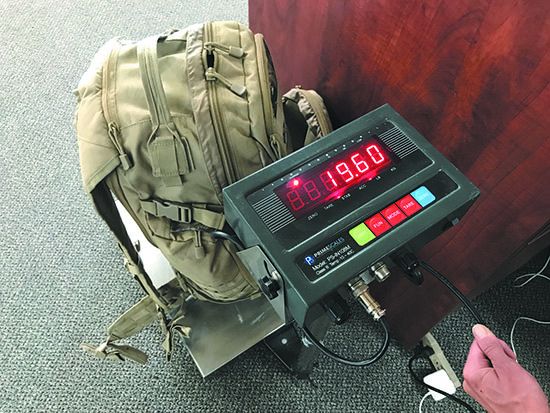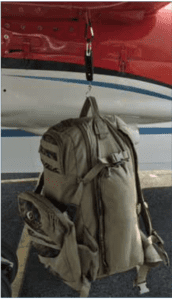
Beech 1900 departs Charlotte and stalls on takeoff, killing all 21 aboard. A Cessna 402 departs Marsh Harbor for Opa-Locka. Instead of landing safely, it crashes 200 feet beyond the departure end of the runway. A Piper Comanche departs Scottsdale, losing control in the climb and becoming a CFIT statistic.
I could keep going, and probably fill this space with accidents or incidents that share a common thread with the three above. But what is that common thread? Operating out of the aircraft’s weight and balance envelope was a significant contributing factor in their respective accidents. (If you’d like to learn more, the flights mentioned above are Air Midwest Flight 5481, N8097W and N9456P.)
As with most accidents, there were other contributing factors. Mechanical failures, get-there-itis, you name it. Links in a chain, or the Swiss cheese model, generally show that more than one issue needs to pop up to cause a fatal accident. In general aviation, we are very fortunate to have almost total control of load quantity and placement. Because of this, each and every flight should be squarely within the weight and balance envelope.
Training vs. The Real World
I have talked before about the limitations of flight training versus real-world flying. My instructor was great about requiring a weight and balance for every flight, but it did get fairly repetitive. Same passenger weights, fuel and payloads. Eventually, I laminated the weight and balance sheet and used a dry erase marker, only making changes on the off-chance we didn’t have full fuel or a back-seater decided to join us. The biggest struggle I faced from a weight and balance standpoint was keeping the aircraft in the utility category for spin training.
Additionally, the flights generally started and ending at the same airport and rarely pushed the aircraft’s range. Skyhawks and Archers are phenomenal trainers but they’re not generally known for their mission capabilities. Many pilots upgrade their equipment to suit their mission. This is where threats can pop up.
In my experience, purchasing or renting a new-to-me airplane triggers a good deal of research. How much can it hold? How far can it go? What kind of airports are suitable? Once that baseline is established, the challenge is combating complacency and procedural drift. We always think it will not happen to us, but none of the pilots in the accidents listed at the beginning of this article set out to flagrantly exceed aircraft limitations. It starts with something like, “Well, it worked last time. One more suitcase can’t hurt,” or, “We just need 10 more gallons of fuel to make it without stopping.”
Even if you are currently not pursuing a new rating, try to continually stay in the training mindset. If you are flight instructing, I highly recommend working with students on scenario-based training. Most folks I meet have an idea of how they intend on using their ratings, and talking them on some mission-style lessons. It is worth throwing some curve balls in the planning phase, simulating real-life scenarios. For example, can this mission be completed with an extra passenger? Or the destination airport just posted a Notam that fuel is unavailable—what would you do? Asking questions like these add an extra layer to fuel planning, demonstrating aircraft capabilities and keeping weight and balance on the forefront of preflight planning.

I am a proponent of making things as easy as possible. If something is easy, it is more likely to be done. Here are some ways to ensure your aircraft is always in the envelope.
Apps and Spreadsheets: ForeFlight and other EFB apps have built-in profiles for calculating weight and balance; it should be an easy task to create them in other EFBs. Additionally, there are spreadsheets available online or you could make your own if you are tech savvy. The most important thing is to periodically cross-check your apps and spreadsheets. It has happened on more than one occasion where I have checked a weight and balance during a lesson or flight review and a default profile was selected instead of the specific airplane. This may not always end up being consequential, but we might as well be diligent while running numbers.
Luggage Scale: If you are a frequent flier and like to check bags, you may have one of these handy already. Obviously, this would be overkill in many light GA aircraft out there, but once you start to get into the four- and six-seat airplanes, their luggage-carrying capability can increase dramatically. I have seen impressive amounts of luggage in planes such as Aztecs and TBMs. I have also seen folks’ tendency to vastly underestimate the weight and quantity of their luggage (especially once kids get involved). A scale rules out any ambiguity.
Common Pitfalls
Working for a Part 135 operation was an awesome experience, but there were some aspects that most folks did not enjoy. As we checked passengers in, we were required to ask their weight. As you can imagine, this could become awkward. Our General Operations Manual actually stated that if we believed the passenger gave us erroneous weight, we could give a conservative estimate and add 10 pounds. It can be too easy to round down and guess low to make a mission work. If some degree of rounding or guesswork is needed, it is worthwhile to reduce your risk factor by rounding up and guessing conservatively.

I always sort of chuckled when my instructor insisted that I strap my flight bag into the back. It seemed silly at the time, but between objects becoming projectiles and their potential to shift in flight, it proved to be a valuable lesson and a good habit. It’s important to remember that the further away an object moves from the datum, the greater the effect on the center of gravity. If you are close to the aft range, and a 50-pound suitcase slides to the rear of the aircraft, it could easily place the aircraft well outside operating limitations.
Also, there is no FAA requirement for small aircraft to be periodically weighed if they are not operating for hire. Many maintenance stations will reweigh aircraft when major maintenance or alterations occur, but many aircraft never undergo this. Additionally, I have personally witnessed flight schools providing pre-filled weight and balance sheets that are inaccurate or out of date. When renting or purchasing a new aircraft, ensure whatever method of madness you use to calculate weight and balance is accurate. Just like any type of calculation, garbage in will produce garbage out.
If your aircraft has different values for max takeoff and max landing weight, it is important to consider this in load planning. Considering all other performance, namely takeoff and landing data, an easy way to calculate MTOW is max landing weight plus fuel burn. Use top of descent as a trigger to ensure you have burned an adequate amount of fuel to land under max landing weight.
Another consideration is that some designs “feature” a center of gravity that moves aft as fuel is burned. If you start out near the aft edge of the envelope, you easily can be beyond it on reaching your destination. If you fly one of these airplanes, run the numbers projected for the end of the flight, too.
If there’s too much fuel aboard and you’ll be over the max landing weight at arrival, there are many ways to creatively burn a little extra fuel if required, such as a hold or throwing some drag out earlier than normal. It is painful, but better than the potential consequences of exceeding aircraft limitations.
I have consistently seen confusion around weight and balance requirements under FAR Part 91. Here’s a brief breakdown.
- FAR 91.9 states that no person may operate a civil aircraft without complying with the operating limitations specified by the Airplane Flight Manual. This FAR also states that the AFM must be available aboard the aircraft.
- FAR 23.2620 requires that the AFM must contain loading information; and other information that is necessary for safe operation because of design, operating or handling characteristics.
- FAR 91.103 states that runway length must be considered, and takeoff and landing data must be calculated.
To make a long story short, you need to operate within the envelope and weight and balance information needs to be published in the AFM. Most confirm this with an ARROW check. Additionally, the AFM will require weight information to calculate takeoff and landing data. Technically, a full weight and balance calculation is not required by regulation. That being said, how else can you demonstrate the above without one? Better to just do a weight and balance. It makes ramp checks go much more smoothly.
Weighing In
Keeping the aircraft operating within its limit is a continuous endeavor. Combining the normalization of deviance with over-engineered airplanes can create a false sense of security. The reality is most aircraft are capable of taking off outside the envelope to some degree. But by doing so, you substantially reduce safety margins built in by the manufacturer and guided by regulation. There are some things in aviation that can pop up unexpectedly, or at least with very subtle warnings. What a pilot chooses to put in their airplane and how they choose to load it is one risk factor we can always control.
One of my favorite mitigation strategies for combating complacency is imagining that every flight has an FAA inspector on board. It is sort of the aviation equivalent to “act like your mother is watching.” In many accidents and incidents involving weight and balance, there were additional links in the chain before the crash occurred. Consider all the risk factors that add up when operating outside the envelope. Now imagine windshear on takeoff, or a warmer-than-expected departure at a high-altitude airport. Engine troubles are far riskier if the aircraft is too heavy or has an exceedingly aft center of gravity.
Next time you are pressed to push beyond the limits of an aircraft, consider the next hazard. Operating the aircraft the way it was designed is something we have autonomy over and will always give us the best shot to overcome the unexpected.
Aft and Heavy
When I think of heavy payloads, I admit my first concern is exceeding max takeoff or landing weight. While this is certainly possible, excess cargo can quickly push the aircraft beyond the aft limit. Combined with being overweight, a beyond-the-aft-limit center of gravity is probably the most hazardous way an aircraft can be loaded. Some mitigation strategies include loading heavier passengers more forward and planning a fuel stop if saving some weight is required. People generally like to avoid fuel stops, but personally I have never minded an opportunity to stretch my legs and use the restroom.
After a career as a Part 135 pilot, flight instructor and check airman, Ryan Motte recently got hired by a major airline and is now flying as a Part 121 first officer.



